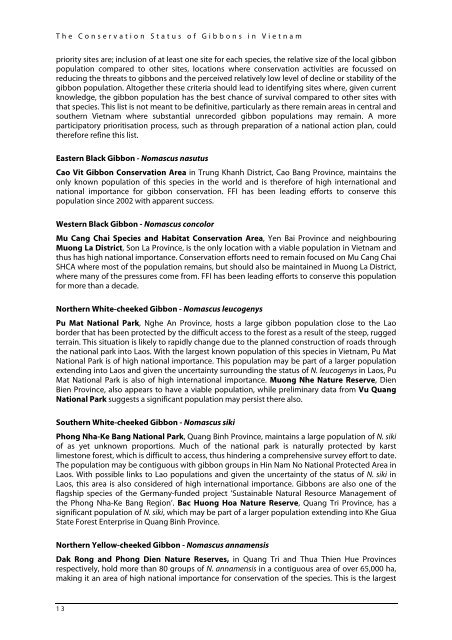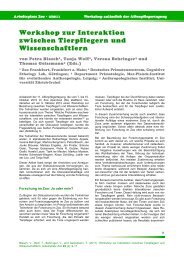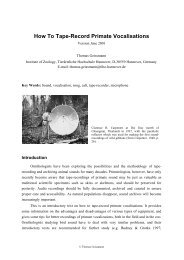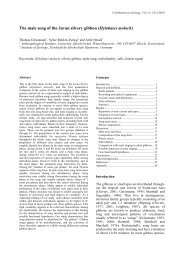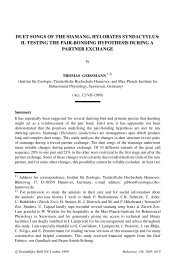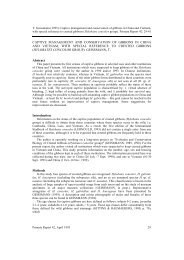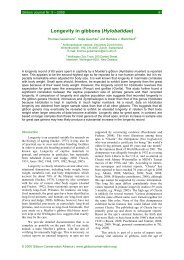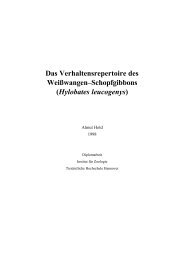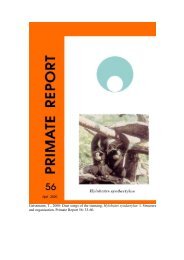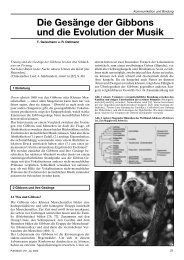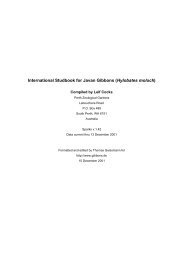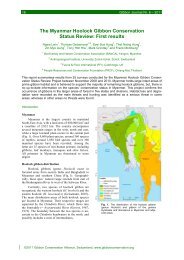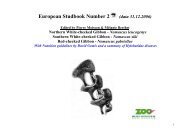The Conservation Status of Gibbons in Vietnam - Gibbon Research ...
The Conservation Status of Gibbons in Vietnam - Gibbon Research ...
The Conservation Status of Gibbons in Vietnam - Gibbon Research ...
Create successful ePaper yourself
Turn your PDF publications into a flip-book with our unique Google optimized e-Paper software.
<strong>The</strong> <strong>Conservation</strong> <strong>Status</strong> <strong>of</strong> <strong><strong>Gibbon</strong>s</strong> <strong>in</strong> <strong>Vietnam</strong>priority sites are; <strong>in</strong>clusion <strong>of</strong> at least one site for each species, the relative size <strong>of</strong> the local gibbonpopulation compared to other sites, locations where conservation activities are focussed onreduc<strong>in</strong>g the threats to gibbons and the perceived relatively low level <strong>of</strong> decl<strong>in</strong>e or stability <strong>of</strong> thegibbon population. Altogether these criteria should lead to identify<strong>in</strong>g sites where, given currentknowledge, the gibbon population has the best chance <strong>of</strong> survival compared to other sites withthat species. This list is not meant to be def<strong>in</strong>itive, particularly as there rema<strong>in</strong> areas <strong>in</strong> central andsouthern <strong>Vietnam</strong> where substantial unrecorded gibbon populations may rema<strong>in</strong>. A moreparticipatory prioritisation process, such as through preparation <strong>of</strong> a national action plan, couldtherefore ref<strong>in</strong>e this list.Eastern Black <strong>Gibbon</strong> - Nomascus nasutusCao Vit <strong>Gibbon</strong> <strong>Conservation</strong> Area <strong>in</strong> Trung Khanh District, Cao Bang Prov<strong>in</strong>ce, ma<strong>in</strong>ta<strong>in</strong>s theonly known population <strong>of</strong> this species <strong>in</strong> the world and is therefore <strong>of</strong> high <strong>in</strong>ternational andnational importance for gibbon conservation. FFI has been lead<strong>in</strong>g efforts to conserve thispopulation s<strong>in</strong>ce 2002 with apparent success.Western Black <strong>Gibbon</strong> - Nomascus concolorMu Cang Chai Species and Habitat <strong>Conservation</strong> Area, Yen Bai Prov<strong>in</strong>ce and neighbour<strong>in</strong>gMuong La District, Son La Prov<strong>in</strong>ce, is the only location with a viable population <strong>in</strong> <strong>Vietnam</strong> andthus has high national importance. <strong>Conservation</strong> efforts need to rema<strong>in</strong> focused on Mu Cang ChaiSHCA where most <strong>of</strong> the population rema<strong>in</strong>s, but should also be ma<strong>in</strong>ta<strong>in</strong>ed <strong>in</strong> Muong La District,where many <strong>of</strong> the pressures come from. FFI has been lead<strong>in</strong>g efforts to conserve this populationfor more than a decade.Northern White-cheeked <strong>Gibbon</strong> - Nomascus leucogenysPu Mat National Park, Nghe An Prov<strong>in</strong>ce, hosts a large gibbon population close to the Laoborder that has been protected by the difficult access to the forest as a result <strong>of</strong> the steep, ruggedterra<strong>in</strong>. This situation is likely to rapidly change due to the planned construction <strong>of</strong> roads throughthe national park <strong>in</strong>to Laos. With the largest known population <strong>of</strong> this species <strong>in</strong> <strong>Vietnam</strong>, Pu MatNational Park is <strong>of</strong> high national importance. This population may be part <strong>of</strong> a larger populationextend<strong>in</strong>g <strong>in</strong>to Laos and given the uncerta<strong>in</strong>ty surround<strong>in</strong>g the status <strong>of</strong> N. leucogenys <strong>in</strong> Laos, PuMat National Park is also <strong>of</strong> high <strong>in</strong>ternational importance. Muong Nhe Nature Reserve, DienBien Prov<strong>in</strong>ce, also appears to have a viable population, while prelim<strong>in</strong>ary data from Vu QuangNational Park suggests a significant population may persist there also.Southern White-cheeked <strong>Gibbon</strong> - Nomascus sikiPhong Nha-Ke Bang National Park, Quang B<strong>in</strong>h Prov<strong>in</strong>ce, ma<strong>in</strong>ta<strong>in</strong>s a large population <strong>of</strong> N. siki<strong>of</strong> as yet unknown proportions. Much <strong>of</strong> the national park is naturally protected by karstlimestone forest, which is difficult to access, thus h<strong>in</strong>der<strong>in</strong>g a comprehensive survey effort to date.<strong>The</strong> population may be contiguous with gibbon groups <strong>in</strong> H<strong>in</strong> Nam No National Protected Area <strong>in</strong>Laos. With possible l<strong>in</strong>ks to Lao populations and given the uncerta<strong>in</strong>ty <strong>of</strong> the status <strong>of</strong> N. siki <strong>in</strong>Laos, this area is also considered <strong>of</strong> high <strong>in</strong>ternational importance. <strong><strong>Gibbon</strong>s</strong> are also one <strong>of</strong> theflagship species <strong>of</strong> the Germany-funded project ‘Susta<strong>in</strong>able Natural Resource Management <strong>of</strong>the Phong Nha-Ke Bang Region’. Bac Huong Hoa Nature Reserve, Quang Tri Prov<strong>in</strong>ce, has asignificant population <strong>of</strong> N. siki, which may be part <strong>of</strong> a larger population extend<strong>in</strong>g <strong>in</strong>to Khe GiuaState Forest Enterprise <strong>in</strong> Quang B<strong>in</strong>h Prov<strong>in</strong>ce.Northern Yellow-cheeked <strong>Gibbon</strong> - Nomascus annamensisDak Rong and Phong Dien Nature Reserves, <strong>in</strong> Quang Tri and Thua Thien Hue Prov<strong>in</strong>cesrespectively, hold more than 80 groups <strong>of</strong> N. annamensis <strong>in</strong> a contiguous area <strong>of</strong> over 65,000 ha,mak<strong>in</strong>g it an area <strong>of</strong> high national importance for conservation <strong>of</strong> the species. This is the largest13


